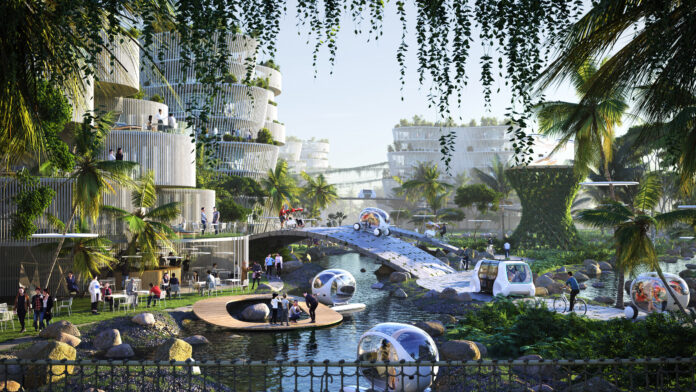An artist’s impression of BiodiverCity by BIG and Hijjas Architects and Planners. — Picture courtesy of BIG
GEORGE TOWN, June 15 — The Penang South Islands (PSI) project, also known as the Penang South Reclamation (PSR) project, has been a hot-button issue in recent weeks with everybody — both sides of the political divide, civil society and neighbourhood uncles and aunties — weighing in.
So, what exactly is the PSI? It’s a massive reclamation project to create three islands off the southern coast of Penang island.
The islands, loosely named A, B and C, will measure a total 4,500 acres (1,821 ha) in land size off the coastal village of Permatang Damar Laut.
The project was first introduced back in 2015 as the funding module for the RM46 billion Penang Transport Master Plan (PTMP) after SRS Consortium was appointed as the project delivery partner (PDP) on August 14, 2015.
SRS Consortium comprises Gamuda Berhad (60 per cent), Penang-based Loh Phoy Yen Holdings Sdn Bhd (20 per cent) and Ideal Property Development Sdn Bhd (20 per cent).
The PTMP was first introduced as a “comprehensive, efficient and well-connected transport strategy” for an integrated and modern transport framework that included public, private, land and sea transportation systems.
The mega project included proposals for highways, LRT, monorail, bus rapid transit, trams, ferries and water taxis with PSI as the funding module.
The proposed RM6.3 billion three paired roads and undersea tunnel project, to be implemented by a different PDP — Zenith Consortium — was also included in the PTMP but this component is to be funded through a different funding module.
The Penang state government planned to implement the two priority components of the PTMP first: the Pan Island Link 1 (PIL1) and the Bayan Lepas—George Town LRT line (BL LRT).
PIL1 is a 19.5 kilometre highway, estimated to cost RM7.5 billion, consisting of 7.6 kilometres of viaduct sections, four tunnel sections totalling 10.1 kilometres in length and embankment sections totalling 1.8 kilometres.
PIL1, which links Gurney Drive to Bayan Lepas, will have six interchanges linking all major hubs.
It will integrate with the north coastal paired road, Gurney Drive paired road, Air Itam and Tun Dr Lim Chong Eu Expressway Bypass, first and second Penang bridge, the proposed undersea tunnel and Tun Dr Lim Chong Eu Expressway.
The Environmental Impact Assessment (EIA) report for PIL1 was approved by the Department of Environment (DoE) on April 10, 2019 with 56 conditions.
The BL LRT is estimated to cost RM8.4 billion and it will stretch from Bayan Lepas to George Town and will also be linked to Penang South Reclamation (PSR) once the islands are reclaimed.
The rail line is estimated to cover 29.5 kilometres and will have 27 stations linking the Penang International Airport in Bayan Lepas with Komtar in George Town.
However, due to a lack of funds, the state is pushing forward with the PSI first in order to raise funds for the construction of PIL1 and the BL LRT.
Approval for the BL LRT from the Transport Ministry is still pending.
Approvals for PSI
The EIA for PSI was on public display twice, once in 2017 and after it was rejected by the DoE in 2018, a revised EIA was submitted in February 2019.
The revised EIA was on public display between April 29 and May 28, 2019.
A total 371 feedback were received from the public in 2017 and another 834 feedback in 2019.
The National Physical Planning Council (NPPC) gave the green light to PSI in April 2019 with 18 conditions and subject to other required approvals.
On June 25 in 2019, the DoE approved the EIA for the PSI but it comes attached with 72 conditions that the state has to comply with.
Among the conditions listed is the implementation of offset programmes and an environment management plan (EMP) to address the environmental impact of the massive reclamation project.
The first EMP was submitted to the DoE on July 17, 2020 but it was not approved at the time.
The state submitted an amended EMP in January 2021 but withdrew it as the DoE said it did not follow the original order of the proposed reclamation as listed in its EIA report.
According to Infrastructure and Transport Committee Chairman Zairil Khir Johari, a new EMP was submitted again this month (June 2021).
The EMP is the last approval that the state will need before it can start on the reclamation project.
“Once the EMP is approved by the DoE, physical works on the three-island reclamation will be able to start,” Zairil said when contacted.
What makes up PSI
The PSI consists of three islands — A, B and C.
Island A will be the largest, measuring at 2,300 acres (930 ha) to be followed by Island B at 1,400 acres (566 ha) and Island C the smallest at 800 acres (323 ha).
According to the EIA report, a majority of the land on the islands will be for residential use (31.2 per cent) covering 1,402 acres (567 ha) to be followed by industrial lots (23.2 per cent) covering 1,045 acres (422 ha).
The remaining land will be allocated for mixed use (13.9 per cent) covering 625 acres (252 ha), open spaces (11.4 per cent) covering 514 acres (208 ha), institutions (6.5 per cent) covering 292 acres (118 ha) and commercial use (4.8 per cent) covering 216 acres (87 ha) and the rest of the 406 acres (164 ha) for roads.
The Penang state government launched the Masterplan Design Competition (MDC) in November 2019 to acquire design proposals for the PSI.
The state received 124 submissions from 26 countries and five consortium teams were selected in January 2020 to submit masterplan design proposals.
Bjarke Ingels Group (BIG) and Hijjas Architects and Planners with their proposal titled “BiodiverCity Penang” was selected as the winner on August 19, 2020.
According to information from BIG’s website, the three islands are of an urban lily pad design.
The islands will consist of mixed-use districts to accommodate between 15,000 to 18,000 residents across 50 to 500 acres with a 50- to 100-metre buffer around each district that will be used as nature reserves and parks.
The residents will rely on localised water resources, renewable energy and waste management and they will be connected by autonomous water-, air- and land-based transportation to make BiodiverCity a car-free area with priority given to cyclists and pedestrians.
The buildings on the islands will mostly be constructed using a combination of bamboo, Malaysian timber and “green concrete” that uses recycled materials as aggregate.
The first island, named The Channels (Island A), will comprise of a civic heart for the government and research institutions, a cultural coast district that will resemble George Town to draw in visitors and a 500-acre (202 ha) digital park for research, development and local business opportunities where technology, robotics and virtual reality can be explored.
The second island, named The Mangroves (Island B), is dedicated to businesses and will be built around a network of sheltered urban wetlands and at the heart of this island is the Bamboo Beacon which is for meeting, incentive, convention, and exhibition (MICE) events.
The third and final island, named The Laguna (Island C), will consist of eight smaller islands to form a small archipelago with a central marina and it will have floating, stilted and terraced housing for residents while providing spawning grounds to develop new marine habitats.
An artist’s impression of BiodiverCity, the winning design for the Penang South Islands project. — Picture courtesy of BIG
BIG and Hijjas Architects and Planners will be working with the state government, the Penang Infrastructure Corporation Sdn Bhd (PIC) and SRS to design the islands.
In March this year, Gamuda Bhd revealed its plans to start reclamation of 1,200 acres of Island A this year once all relevant approvals are obtained.
Gamuda Bhd deputy group managing director Mohammed Rashdan Yusof said in a report the reclamation of 1,200 acres (485 ha) is estimated to cost between RM6 billion to RM7 billion and that it will span five years.
He added that a total 700 acres (283 ha) of the land will be allocated for a green tech park that is targeted at high-value electronics and electrical multinational companies to complement the nearby Bayan Lepas Free Industrial Zone.
According to the Penang Deputy Chief Minister I Datuk Ahmad Zakiyuddin Abdul Rahman, phase one of the project to reclaim 1,200 acres (485ha) is expected to be complete between 2026 and 2027.
Island A will only be about 250 metres from the shoreline of Permatang Damar Laut in the southern coast of Penang island.
Phase One of the reclamation will start at the eastern tip of Island A which is about 600 metres from Pulau Rimau.
The reclamation will be fully funded by SRS Consortium and it will be implemented by a joint venture (JV) with the Penang state government.
Under the JV, a company will be created by the state with SRS Consortium holding 70 per cent share while the state’s interest of 30 per cent will be represented by PIC.
Controversies
The PTMP and PSI have drawn criticism and objections from various civil society groups, fishermen and politicians from both sides of the political divide.
Penang Forum’s Khoo Salma started an online petition ”Save Penang! Reject the 3-Islands Reclamation” addressed to the prime minister and as at June 11, it has garnered over 120,000 signatures.
Penang Forum is a loose coalition of non-governmental organisations (NGOs) in Penang that has been vocal in its objections against components under the PTMP and the PSI.
Since 2019, Penang Forum along with 45 other NGOs have held numerous talks, forums, protests, demonstrations and released a number of statements calling for the PSI to be scrapped entirely.
One of the reasons raised was the dumping of 190 million cubic meters of fill material comprising sand and rock into the ocean to create the three islands.
According to the Consumers Association of Penang (CAP), that amount of sand dumped into the ocean to create the islands is equivalent to the size of 76,000 Olympic-size swimming pools.
It further pointed out that the impact of the reclamation will effectively destroy one of the richest fishing grounds in Penang and this will affect the livelihoods of about 5,000 fishermen.
The NGOs have also questioned the need to create man-made islands when there is more than sufficient land in Seberang Perai, the mainland part of the state.
A group of fishermen also filed an appeal against the DoE’s approval of the EIA for PSI and the hearing is set to be heard from July 12 to 14.
It was not long before politicians joined in the chorus of criticism against the PSI in recent weeks. These included PKR’s Permatang Pauh MP Nurul Izzah Anwar, PKR Bukit Bendera division director of communications Mah Kong Lip, Gerakan deputy president Oh Tong Keong, Kepala Batas MP and youth and sports minister Reezal Merican Naina Merican and most recently, Deputy Minister of Agriculture and Food Industries II Datuk Che Abdullah Mat Nawi.
Entrepreneur Development and Co-operatives Minister Datuk Sri Wan Junaidi Tunku Jaafar has also reiterated his objection against the PSI project.
He had objected to the project back in 2017 when he was the minister of Natural Resources and Environment and the project was brought to his attention.
Among the reasons for the objections were the destruction of the environment and rich marine ecosystem around Penang island including landing and nesting grounds of endangered species of turtles such as Olive Ridley and Green turtles.
According to Che Abdullah, the project will negatively impact 4,996 fishermen in Penang and destroy marine catch landings of about 51,184 metric tons worth about RM525 million a year.
“It will also affect 511 aquaculture farms that produce 54,742 metric tons of fish output worth about RM1.67 billion a year,” he said in his statement dated June 10.
Penang state government’s stand
In response to the objections and criticisms, Zairil Khir Johari stressed that the state government is offering ex-gratia packages and programmes that will provide long-term benefits to the 1,615 affected fishermen.
He said there will be re-skilling programmes for full-time fishermen to provide them with stable employment and income during the course of the project.
Penang Chief Minister Chow Kon Yeow also released a detailed statement claiming the state has taken climate change into consideration in the planning of the project.
“We never denied that the project will have an impact but we have always shared with the people how we intend to mitigate the impact, create new habitats for marine life, and provide more jobs and business opportunities for fishermen and other locals,” he said.
He said the state is obligated to carry out offset programmes to manage the impact on fisheries resources and fishermen, as stated in the DoE’s EIA approval.
“The Offset Programme is to include artificial reefs, Fishery Aggregating Device (FAD), mangrove planting, release of fish fry, building eco-engineering structures, funding for studies and research, and other programmes as recommended in the EIA report,” he said.
He also said 20 per cent of the PSI land will be reserved for green parks, mangroves, water canals, wetlands, floodplains and bioswales to enhance biodiversity.
He added that the state had engaged with the local fishing community for over five years and a total 6,153 fishermen have been involved in stakeholder engagements since PSI was mooted in 2015.
Based on 2015 data from the Fisheries Department, Chow said fish landing fishermen units around the PSI area only contributed about four per cent of Penang’s total fish production.
He also said fish landings recorded within Zone A, which is less than eight nautical miles from the shore, in southern Penang only contributes 10 per cent of total fish landings while the remaining were from large trawlers who operate in deeper waters.
In addition, he said over 5,000 units of affordable homes will be built near canal waterways, public parks, schools, community sports centres and other public amenities.
Both Chow and Zairil stressed that the state needed the PSI to create jobs and stimulate the state’s economy through domestic and international investments.
They both claim it will be a catalyst to spur the state’s economy in future to alleviate the impact from the Covid-19 pandemic.
Chow clearly said the state will not cancel the project and had called on the federal government, particularly the DoE, not to rescind its approval of the EIA.
What’s next?
The state is set to kick start the project very soon, upon receiving the approval for the EMP it submitted early this month (June 2021).
The initial plan was to start the reclamation of phase one of Island A in late May or early this month (June) but this was delayed due to the resubmission of the EMP for approval.
Despite the appeal against the EIA approval pending to be heard in July, Zairil said physical works will start the moment they obtain approval for the EMP.
He said the hearing of the appeal will still go on even if the physical works of the reclamation have started.
“We were hoping the EMP will be approved by now but this was delayed as we had to make an amendment and resubmit it this month,” he said.


